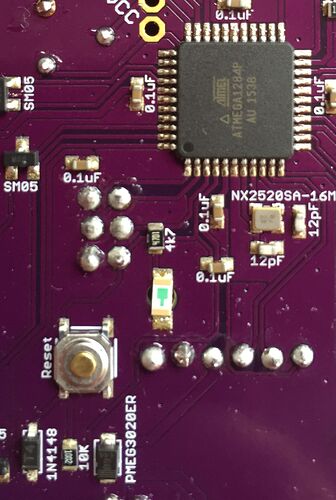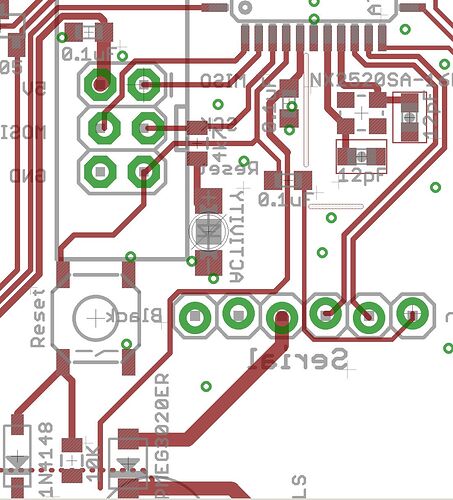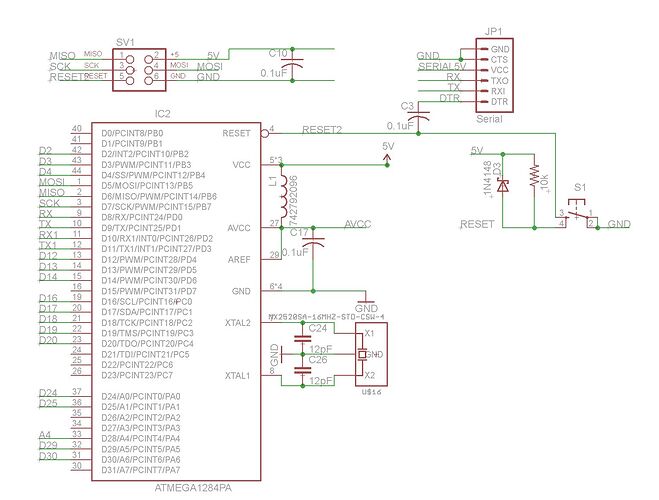Hi everyone,
After a bit of a hiatus, I am once again having some fun with a DIY 1284P board. I've followed the paths of the pioneers (i.e. maniac bug and Mr. Crossroads) re: the circuit design with some minor changes. I wonder if I may have been tripped up by said changes, so here first is the error message I got from my MKII AVR ISP when I tried to upload blink tonight:
avrdude: Version 6.0.1, compiled on Jan 15 2015 at 12:42:51
Copyright (c) 2000-2005 Brian Dean, http://www.bdmicro.com/
Copyright (c) 2007-2009 Joerg WunschSystem wide configuration file is "/Applications/Arduino.app/Contents/Resources/Java/hardware/tools/avr/etc/avrdude.conf"
User configuration file is "/Users/CvW/.avrduderc"
User configuration file does not exist or is not a regular file, skippingUsing Port : usb
Using Programmer : stk500v2
avrdude: usbdev_open(): Found AVRISP mkII, serno: 000200074270
AVR Part : ATmega1284P
Chip Erase delay : 55000 us
PAGEL : PD7
BS2 : PA0
RESET disposition : dedicated
RETRY pulse : SCK
serial program mode : yes
parallel program mode : yes
Timeout : 200
StabDelay : 100
CmdexeDelay : 25
SyncLoops : 32
ByteDelay : 0
PollIndex : 3
PollValue : 0x53
Memory Detail :Block Poll Page Polled
Memory Type Mode Delay Size Indx Paged Size Size #Pages MinW MaxW ReadBack
eeprom 65 10 128 0 no 4096 8 0 9000 9000 0xff 0xff
flash 65 10 256 0 yes 131072 256 512 4500 4500 0xff 0xff
lock 0 0 0 0 no 1 0 0 9000 9000 0x00 0x00
lfuse 0 0 0 0 no 1 0 0 9000 9000 0x00 0x00
hfuse 0 0 0 0 no 1 0 0 9000 9000 0x00 0x00
efuse 0 0 0 0 no 1 0 0 9000 9000 0x00 0x00
signature 0 0 0 0 no 3 0 0 0 0 0x00 0x00
calibration 0 0 0 0 no 1 0 0 0 0 0x00 0x00Programmer Type : STK500V2
Description : Atmel STK500 Version 2.x firmware
Programmer Model: AVRISP mkII
avrdude: stk500v2_recv_mk2: error in USB receive
Hardware Version: 2
Firmware Version Master : 1.10
Vtarget : 4.9 V
SCK period : 8.00 usavrdude: stk500v2_command(): command failed
avrdude: stk500v2_program_enable(): bad AVRISPmkII connection status: Unknown status 0x00
avrdude: initialization failed, rc=-1
Double check connections and try again, or use -F to override
this check.avrdude done. Thank you.
Error while burning bootloader.
My question to the experts: Does the above suggest that the board is alive or may I have cooked the MCU in the reflow oven?
Now for the changes I made that may also be the cause of the above unhappiness: Instead of the resonators I have used in the past, I switched to a crystal: CS05116-16M NDK America, Inc. | Crystals, Oscillators, Resonators | DigiKey
Unfortunately, I managed to order the wrong version of the crystal - the 12pF load capacitance version instead of the 8pF model I intended to order. Thus, my calculated 12pF external capacitors are obviously wrong and need to be replaced. Would 20-22pF caps look like a better bet?
FWIW, I am running Arduino 1.6.1 on a OSX 10.10 machine. I downloaded the mighty library for version 1.6 from github... Many thanks to all again, this is an amazing forum and community.




